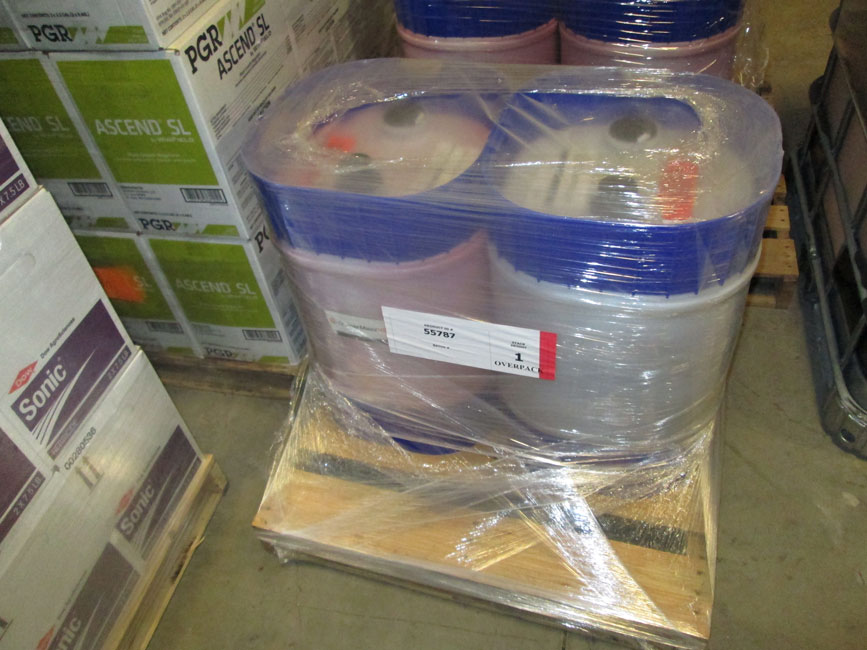
- Read and follow label instructions. Label instructions will provide the appropriate information for use, safe handling, and storage for the particular product. Following label instructions will help you avoid misuse, human health risks, and possible environmental contamination.
- Open and partial containers or broken bags of pesticide cannot be resold.
- Broken bags of fertilizer containing pesticide cannot be resold.
Storage Recommendations
The following recommendations will reduce the chance of harm to humans, wildlife, and contamination to surface or ground water.
PESTICIDE STORAGE, SALES AND USE
- Pesticides must be separated from food, feed, seed,and other products and stored in a manner that prevents contamination which would cause injury or damage other products or materials.
- Pesticide products cannot be stored near an open drain. If an open drain is present in a pesticide storage area, pesticides should be moved to a different location and secured in a nonflammable containment area such as a leak-proof metal container or the drain should be permanently closed.
- Always follow the pesticide label for proper storage, safety precautions, and directions for use. The label is the law.
- Small packaged pesticides being offered for sale must be in unopened and sealed containers.
- Small packaged pesticides may only be stored in the original container.
- All pesticides being distributed or offered for sale must be currently registered for use in Minnesota and in properly labeled containers.
- A person may not allow any pesticide or pesticide rinsate to be stored, kept, or to remain on any site without safeguards adequate to prevent an incident.
WASTE PESTICIDES
Banned or old pesticides which are no longer registered for use in Minnesota must be securely stored and adequately safeguarded. These pesticides may not be used, sold, or otherwise distributed. For information regarding disposal of unwanted, old and no longer registered, or banned pesticides, call your county’s Household Hazardous Waste Collection Facility or Department.
EMPTY PESTICIDE CONTAINERS
-
Unrinsed pesticide containers must be held in a secure and safeguarded area to prevent an incident from occurring.
-
Pesticide containers must be properly rinsed (triple or pressure rinsed) and then may be disposed of through reconditioning, recycling rinsed program, or disposal at a sanitary landfill (dependent upon type of container). Unrinsed or improperly rinsed containers cannot be legally disposed of in Minnesota.
- Do not reuse empty pesticide containers.
- Check with your pesticide retailer for pesticide container recycling options. Pesticide containers cannot be recycled through curbside or household recycling programs.
- For detailed information contact your pesticide retailer or the MDA at 651-201-6136.
RINSATE DISPOSAL
All rinsate produced by rinsing of pesticide containers, washing of equipment, or changing chemicals must be disposed of according to label directions. This can be accomplished by using the rinsate as “make-up” water in the tank mix or by applying the rinsate to a site as specified by product label directions.
BACKFLOW PREVENTION DEVICES
Firms must have an adequate blackflow prevention device on their water supply when filling application equipment. The MDA strongly recommends a backflow prevention device for rinsing pesticide containers at a facility. A backflow prevention device(s) must comply with the Minnesota Plumbing Code under Minnesota Rules. For more information, see the fact sheet Backflow Prevention Guidelines for Filling and Rinsing Fertilizer or Pesticide Application Tanks.
INCIDENT RESPONSE PLAN
An incident response plan is required for those firms that have any of the following licenses:
- Bulk Pesticide Dealer’s License
- Commercial Pesticide Applicator’s License
- Commercial Aquatic Pest Control Company/Applicator Licenses
- Structural Pest Control Company/Applicator Licenses
- Noncommercial Pesticide Applicator’s License
RECOMMENDED MANAGEMENT PRACTICES
- Small packaged pesticide containers should be stored on an impervious surface and off the floor.
- Entrances to pesticide storage areas should be posted with warning signs.
- A State Emergency Incident Notification placard should be posted at the firm’s place of business.
- Pesticide storage areas should have sufficient lighting and be adequately ventilated.
- A floor plan of pesticide storage area should be filed with the local fire department.
- Schedule annual inspections of the pesticide storage facility with the local fire department.
- A fire extinguisher rated for materials stored should be present in the pesticide storage area.

